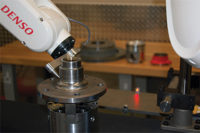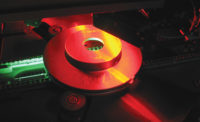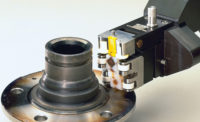For more than 50 years, Distance Gain Size (DGS) inspections have been performed for the code compliant flaw detection and sizing of welds across oil and gas, power generation and general fabrication applications. They are also used to inspect tubes, pipes, pressure vessels, containers and pumps. Introduced by Krautkrämer in the late 1950s, the DGS method originally employed straight-beam probes with circular transducers (or crystals), resulting in a rotationally symmetric sound field. The technique, which quickly became a widely accepted inspection method across the globe and found entry into a variety of industry specific norms and codes, records flaw echo amplitude on either a probe-specific printed diagram—a series of curves that represent various disc size reflectors to sound path and gain—or a generic diagram applicable for straight- and angle-beam ultrasonic probes.
Most commonly used for analyzing welds and work pieces, the DGS method relies on an ultrasonic inspector to manually fit a display flaw indication to the DGS curve diagram to determine the equivalent reflector size of the flaw. In the mid-60s, the method expanded to the use of angle-beam probes with rectangular transducers. However, due to the shape of the transducers, non-symmetrical sound beams were produced, which are even more distorted through the refraction at the interface between probe and specimen. At the time, analog ultrasonic testing instruments with small, non-linear screens were most often used. These rudimentary technologies did not enable operators to read incremental gains, such as a tenth of a dB, and distances as small as one-hundredth of a millimeter—giving rise to a host of measurement deviations.
Though several decades have passed since that time, today’s DGS angle beam probes continue to widely leverage rectangular transducers, and as a result of the non-symmetrical sound fields, they tend to oversize flaws and cause unnecessary weld and work piece scrap or rework—all time-consuming and costly mistakes.
How It Works
When using the DGS ultrasonic flaw sizing method, the term equivalent reflector size (ERS) is used when referring to the diameters of flat-bottom holes. For example, a real discontinuity might be stated to have an equivalent reflector size equal to a 3 mm diameter flat-bottom hole. DGS diagramming describes distance laws, which depend solely on the shape of sound beams and reflectors. The determination of the equivalent reflector size is based on the comparison of two echo amplitudes. The echo from an unknown reflector is compared to the echo from a known reflector—or reference reflector. In practice, different types of reflectors can be used as reference reflectors. When testing using normal beams and TR probes, a flat back wall is often used, struck perpendicularly by the sound wave. This can either be the back wall of the work piece itself or the back wall of a reference block.
Application or industry specific norms, codes and regulations then state acceptance or reject criteria by defining ERS sizes which must not be exceeded.
Solving the DGS Oversizing Challenge
Recent in-depth research conducted by a team of nondestructive testing (NDT) experts in Huerth, Germany, sought to resolve the industry-wide and long-standing challenge of rectangular transducer inaccuracy across all types of angle-beam probes on the market.
The study began with the examination of DGS diagrams based on measurements and tests performed with a number of angle beam probes containing different crystal sizes and frequencies.
Further, these comparisons showed a tendency that this deviation is a function of transducer size, frequency and angle of incidence. In other words, the deviation becomes bigger the lower the frequency and/or the larger the crystal and/or the larger the angle of incidence is, regardless of the device manufacturer.
After numerous simulation exercises over a period of time, a solution emerged: Let the angle-beam probes generate in the test materials the same sound field as given straight-beam probes (as the DGS method was originally developed for straight beam probes). Using a reverse calculation approach, the team transferred each beam of the straight-beam probe into the angle-beam probe. Additionally, they built mathematical models based on the Fermat principle, Snell’s Law and the angle-dependent phase shift at the interface between probes to calculate a proper transducer shape. The result was a very uniquely shaped crystal transducer resembling a “tongue,” concavely and convexly curved around both axes.
Subsequent CAD modeling has enabled the manufacture of unique angle-beam probes that can provide a virtually perfect match with their associated DGS diagrams. As a result, ultrasonic inspections using the DGS method are now significantly more accurate and reliable. This will also likely lead to a significant reduction in materials, savings in material scraps and reduced welding rework.
Greater Productivity with Enhanced Phased Array Probes
The same philosophy can also be easily extended to phased array probes. Similarly, the starting point is the simulation of an angle-beam probe in which the angle for the un-phased probe is chosen to be in the middle of the sweeping range (as it is also done for current phased array probes). Next, this simulation is repeated for each phasing angle. Because of the way delay laws are calculated, one additional constraint has to be observed: the peripheral beams of all simulated probes have to be tangential to the perimeter of the crystal simulated in the first step in the azimuthal plane.
By fulfilling this constraint, delay laws can now be easily understood by calculating the distance in units of time between two respective elements in the phased and un-phased probe. To test this theory, a large number of phased array probes were designed and built as part of this study. The following presented results were taken with a phased array probe comparable to a traditional 2 MHz probe with 8 x 9 mm transducer size currently on the market. Three millimeter flat-bottom holes in different depths and with different inclination were chosen for this exercise. In addition to the traditional angles of 45 degrees, 60 degrees and 70 degrees, test blocks with 3 mm flat-bottom holes with 53 degrees and 65 degrees were manufactured and used.
During this study, the resulting enhanced phased array probe surpassed the accuracy of a traditional single element angle-beam probe and is accuracy-wise comparable to a straight-beam probe with circular transducer. Additionally, because it enabled DGS evaluation at every angle between 45 degrees and 70 degrees in one step, probability of detection increased significantly while calibration time decreased from at least one hour to just five minutes—significantly boosting productivity.
Using this new, innovative approach, DGS sizing accuracy can be achieved with angle-beam probes—something that until now could only be achieved with straight-beam probes. The study identified a missing rotationally symmetric sound field as the root cause of significant observed deviations.
By taking a reverse approach, the research team calculated the necessary crystal structure based on sound field rather than iteratively working to optimize the crystal’s shape until the sound field flaw interaction was optimized. Additionally, the approach proved effective for phased array probes. When this method was simulated for every possible phasing angle, the phased array allowed for precise DGS sizing over the complete sweeping range.












